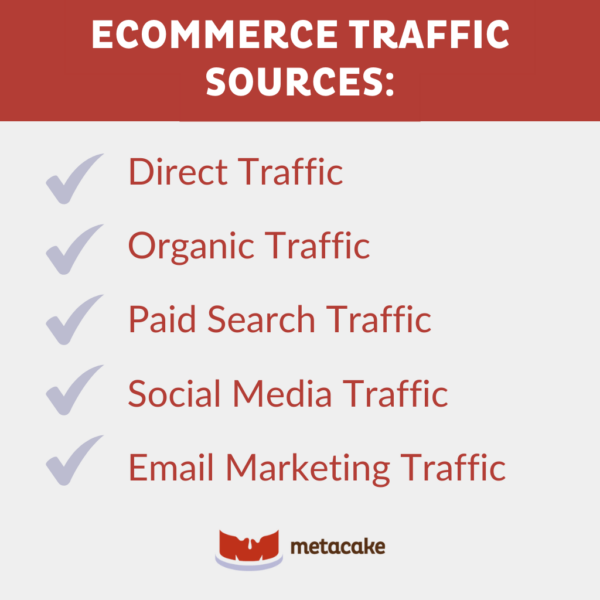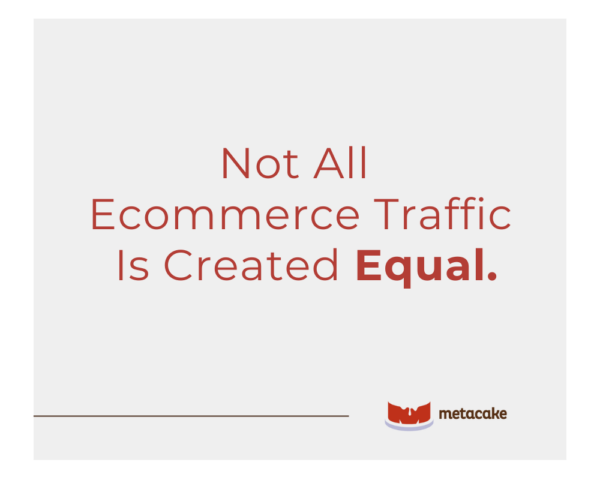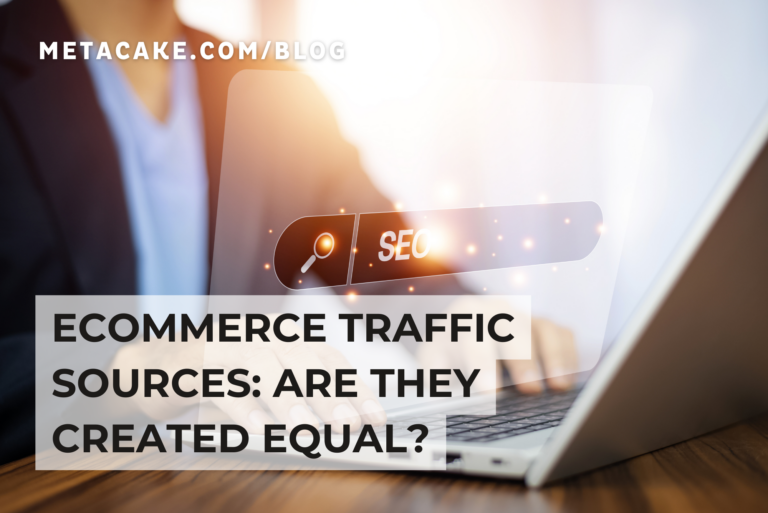It’s safe to say that ecommerce is here to stay. And that’s good news for ecommerce business owners! In 2023, global retail ecommerce sales reached an estimated $5.8 trillion, with projections indicating a 39% growth in this figure over the coming years!
With all that traffic, it’s vital that ecommerce business owners know how to get their fair share — I mean, the traffic is there, so why not direct it your way?
Understanding ecommerce traffic sources is essential for creating successful marketing strategies. So, in this article, we’ll go over the sources of this traffic, how you end up with bad traffic, and how to avoid that bad traffic.

Ecommerce Traffic Sources
If you want to develop a successful marketing strategy, increase online visibility, boost sales, and improve your overall website performance, you need to recognize the sources of this ever-growing ecommerce traffic.
Direct Traffic
This occurs when a visitor arrives at a store by typing the website’s URL directly into their browser’s search bar.
High amounts of direct traffic are often a sign of strong brand recognition and loyalty. In a nutshell, it tells you that you’re doing something right — perhaps by creating a great customer experience!
Direct traffic can be seen as a measurement of the effectiveness of your offline advertising, word-of-mouth referrals, and returning customers.
Ultimately, direct traffic is any website visitor who lands on your site without being recommended by another website.
Organic Traffic
This traffic comes from unpaid search results on engines like Google and Bing.
High organic traffic is indicative of successful search engine optimization (SEO) efforts since users discovered the website through relevant search queries.
Investing in SEO can greatly increase visibility and attract potential customers looking for your products or services.
Paid Search Traffic
When a visitor comes to your site as a result of clicking on ads on search engines like Google, Bing, or even YouTube — yes, YouTube is a search engine — that’s paid search traffic. This traffic is derived from an intent-based marketing strategy.
In our article, The Executive’s Guide to Paid Search Ecommerce Advertising, we dive into seven simple, effective prompts to keep in mind when incorporating paid search advertising into your larger marketing strategy:
- Use paid search.
- Value is more important than price.
- Don’t trick people.
- Paid search doesn’t have infinite volume.
- Buy branded terms.
- Advertise on Google Shopping.
- Advertise on YouTube.
Social Media Traffic
This type of traffic is — yes, you guessed it — visitors coming to your site by clicking on your social media posts. This traffic is a good indicator of how well your social media pages are performing.
Every campaign on every channel must have a unique URL. This is essential to meaningfully tracking the effectiveness of your campaigns and social media channels.
Don’t forget your regular social activity. If you post on Facebook or Instagram, you should track those campaigns. If you’re not tracking them and someone clicks through your post to your site and makes a purchase, you’ll have no idea how to attribute that revenue. You won’t know what’s working and what’s not working or how to improve your social posts over time.
Email Marketing Traffic
This traffic source comes from email subscribers clicking the links in your emails. It provides you with a good overview of how well your email marketing campaign is functioning.
A huge benefit of email marketing is that you own this channel. Why is that important? Let’s look at the downsides of other channels:
- You don’t own social media, search engines, or any other platform you decide to advertise on.
- You have no control over the outcome or longevity of these other channels.
- Their algorithms and rules change frequently.
- They have the potential to shut down your account without any warning.
For these reasons, we don’t advocate relying solely on these paid channels for traffic.
It’s important for ecommerce businesses to monitor these traffic sources and optimize them to improve reach, interaction, conversion, and engagement. Each source has its own potential and effectiveness, and a balanced approach often yields the best results.
Not All Ecommerce Traffic Is Created Equal
Driving more traffic is one of the keys to predictably increasing your revenue.
But not all ecommerce traffic is created equal.
We can tell you countless stories we’ve heard of ecommerce stores that have driven hundreds of thousands of visits to their sites with next to no conversions.
It’s not hard to attract a lot of uninterested buyers. Of course, no one aims to do this, but it happens all of the time (perhaps to no fault of your own), and it leaves you with a slew of problems such as:
- Low conversion rate
- Wasted money (if the traffic was paid)
- Angry site visitors (if they felt tricked to come to your site or didn’t find what they were looking for)
- Useless data (with highly skewed metrics)
- Low (or worse, no) sales
Not to mention that many people end up writing off good strategies due to poor execution — strategies that might prove highly lucrative if they were executed properly.

How Do You End Up With Bad Traffic?
There are three typical ways that businesses end up with a ton of low-quality traffic to their sites (two of which are completely innocent).
1) Brand Confusion
If you have a brand name that is similar to another well-known brand but is completely unrelated, you may end up with a lot of traffic that wasn’t meant to be there.
These visitors were looking for a completely different company and product, so obviously they bounced almost immediately upon visiting your site. This happens a lot when businesses pick common names for their brand name and are in their early stages.
How to avoid this: Develop quality content to improve brand recognition over time, and make sure to be unique and memorable in your messaging.
2) Poor Marketing (Or a Poor Marketing Partner)
This is the not-so-innocent reason. You may be guilty of using unintelligent tactics and simply buying the wrong traffic. This may be due to the wrong messaging, poor customer segmentation and targeting, or the wrong marketing channels.
You don’t want to trick people into coming to your site because they won’t convert anyway. Focus instead on sincere messaging to attract visitors who actually want to be there.
How to avoid this: Get clear on your ideal customer, and ensure your messaging is highly targeted toward that audience. This’ll attract deliberate buyers to your website. Be sure to hire good vendors and require regular reports on performance.
3) Spam Traffic
Many businesses aren’t aware that a significant portion of traffic to their site may be spam traffic, which is one of the most common culprits of low conversion rates.
How to avoid this: There are two ways to deal with spam traffic. You can either filter the spam traffic out of your analytics or block spam traffic from accessing your site in the first place.
Is It Possible to Buy Quality Traffic?
Yes, of course it’s possible! That’s what these platforms are designed for — although some offer better targeting abilities than others.
If you’re looking to get the most targeted traffic, we recommend paid social media channels. They allow you to be very specific about demographics and define a very narrow audience.
However, this traffic is not looking for you, so it can be harder to capture. Paid search advertising, on the other hand, is full of people searching, which means they have more intent to purchase.
Focus on keywords that accurately reflect your brand and your offer to attract traffic that is actively looking for you.
How to Determine What Sources Are Working?
The key is to have a quality analytics implementation and someone who can read and interpret the results, providing actionable insights. This allows you to identify the top landing pages based on conversion, as well as evaluate the various traffic sources and visitor flow to determine where to invest more money and where to cut back.
Watch out for red flags. If you’re receiving a lot of traffic from a country other than your target, or if a significant proportion of your traffic is coming from a single website, check your spam filters to confirm this is legitimate traffic.
Final Thoughts on Ecommerce Traffic
Now that you’re in tune with the different ecommerce traffic sources and how some businesses fall prey to bad traffic (and ways to avoid it), are you ready to direct the good traffic your way?
If it feels like too much to bear on your own, we’re here to guide you on the right path. We have an exceptional team waiting to lend a helping hand. Reach out today and see what we have to offer.
